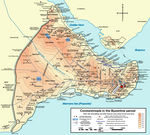The Column of Constantine (Turkish: Çemberlitaş Sütunu; Greek: Στήλη του Κωνσταντίνου Α΄; Latin: Columna Constantini) is a Roman monumental column built for Roman emperor Constantine the Great to commemorate the dedication of Constantinople on 11 May 330 AD. Built c. 328 AD, it is the oldest Constantinian monument in Istanbul and stood in the centre of the Forum of Constantine. It occupies the second-highest hill of the seven hills of Constantine's Nova Roma, the erstwhile Byzantium, and was midway along the Mese odos, the ancient city's main thoroughfare.
The column shaft itself is composed of very large porphyry column drums set on a white marble pedestal that is no longer visible. The column once supported a bronze statue of the emperor holding a spear and wearing a seven-point radiate crown, probably nude, and possibly holding an orb. Its appearance probably referred to the Colossus of Rhodes and to the Colossus of Nero in Rome; all resembled the solar deities Helios or Apollo. The statue and column capital fell down after some eight centuries, and were replaced with a cross, since removed, and the inscribed white marble masonry capital visible today.
The column's top is 34.8 m above the present-day ground level. Estimates of the original height of the column, without the statue, vary between 37 and 40 m; the monument as a whole would have been nearly 50 m tall. It may have been the largest Roman honorific column of all, rivalled only by the later Column of Theodosius, now demolished. Constantine's Column was taller than Trajan's Column and the Column of Marcus Aurelius; its size approached or exceeded the height of the Colosseum (48 m) and the internal height of the Pantheon (43 m) in Rome.
The Turkish name Çemberlitaş, from çemberli 'hooped' and taş 'stone', was applied after renovations by the Ottomans in c. 1515, who added iron reinforcing hoops to the shaft, and the name became a synecdoche for the local area: Çemberlitaş. Bronze reinforcements had first been added as early as 416. The monument sustained fire damage in the 5th and 6th centuries; in 1779, another fire blackened the column, which subsequently became known as the Burnt Pillar.
The column is where Yeniçeriler Caddesi ("Street of the Janissaries") adjoins the Divan Yolu ("Road to the Divan"); these streets connect Sultanahmet Square with Beyazıt Square and roughly follow the course of the old Mese odos. The Roman street led eastward to the Augustaion, the Hippodrome, Hagia Sophia, the Baths of Zeuxippus, and the Chalke Gate of the Great Palace. To the west the way led through the Forum of Theodosius to the Philadelphion and the walls of Constantinople. In Constantine's Forum itself the emperor built the original home of the Byzantine Senate.











